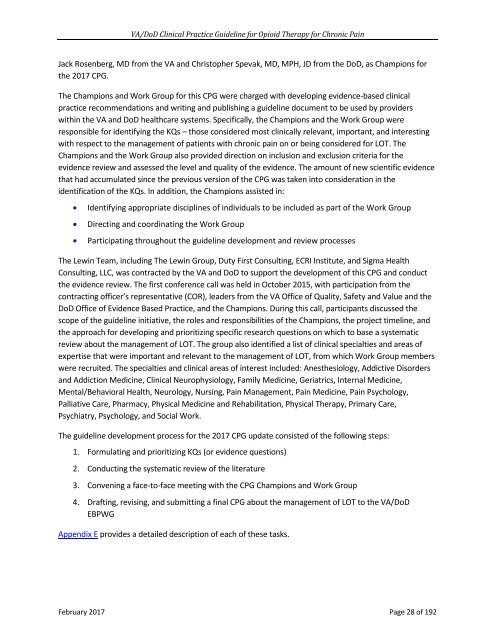VA/DoD CLINICAL PRACTICE GUIDELINE FOR OPIOID THERAPY FOR CHRONIC PAIN
2lfFhbO
2lfFhbO
Create successful ePaper yourself
Turn your PDF publications into a flip-book with our unique Google optimized e-Paper software.
<strong>VA</strong>/<strong>DoD</strong> Clinical Practice Guideline for Opioid Therapy for Chronic Pain<br />
Jack Rosenberg, MD from the <strong>VA</strong> and Christopher Spevak, MD, MPH, JD from the <strong>DoD</strong>, as Champions for<br />
the 2017 CPG.<br />
The Champions and Work Group for this CPG were charged with developing evidence-based clinical<br />
practice recommendations and writing and publishing a guideline document to be used by providers<br />
within the <strong>VA</strong> and <strong>DoD</strong> healthcare systems. Specifically, the Champions and the Work Group were<br />
responsible for identifying the KQs – those considered most clinically relevant, important, and interesting<br />
with respect to the management of patients with chronic pain on or being considered for LOT. The<br />
Champions and the Work Group also provided direction on inclusion and exclusion criteria for the<br />
evidence review and assessed the level and quality of the evidence. The amount of new scientific evidence<br />
that had accumulated since the previous version of the CPG was taken into consideration in the<br />
identification of the KQs. In addition, the Champions assisted in:<br />
• Identifying appropriate disciplines of individuals to be included as part of the Work Group<br />
• Directing and coordinating the Work Group<br />
• Participating throughout the guideline development and review processes<br />
The Lewin Team, including The Lewin Group, Duty First Consulting, ECRI Institute, and Sigma Health<br />
Consulting, LLC, was contracted by the <strong>VA</strong> and <strong>DoD</strong> to support the development of this CPG and conduct<br />
the evidence review. The first conference call was held in October 2015, with participation from the<br />
contracting officer’s representative (COR), leaders from the <strong>VA</strong> Office of Quality, Safety and Value and the<br />
<strong>DoD</strong> Office of Evidence Based Practice, and the Champions. During this call, participants discussed the<br />
scope of the guideline initiative, the roles and responsibilities of the Champions, the project timeline, and<br />
the approach for developing and prioritizing specific research questions on which to base a systematic<br />
review about the management of LOT. The group also identified a list of clinical specialties and areas of<br />
expertise that were important and relevant to the management of LOT, from which Work Group members<br />
were recruited. The specialties and clinical areas of interest included: Anesthesiology, Addictive Disorders<br />
and Addiction Medicine, Clinical Neurophysiology, Family Medicine, Geriatrics, Internal Medicine,<br />
Mental/Behavioral Health, Neurology, Nursing, Pain Management, Pain Medicine, Pain Psychology,<br />
Palliative Care, Pharmacy, Physical Medicine and Rehabilitation, Physical Therapy, Primary Care,<br />
Psychiatry, Psychology, and Social Work.<br />
The guideline development process for the 2017 CPG update consisted of the following steps:<br />
1. Formulating and prioritizing KQs (or evidence questions)<br />
2. Conducting the systematic review of the literature<br />
3. Convening a face-to-face meeting with the CPG Champions and Work Group<br />
4. Drafting, revising, and submitting a final CPG about the management of LOT to the <strong>VA</strong>/<strong>DoD</strong><br />
EBPWG<br />
Appendix E provides a detailed description of each of these tasks.<br />
February 2017 Page 28 of 192


